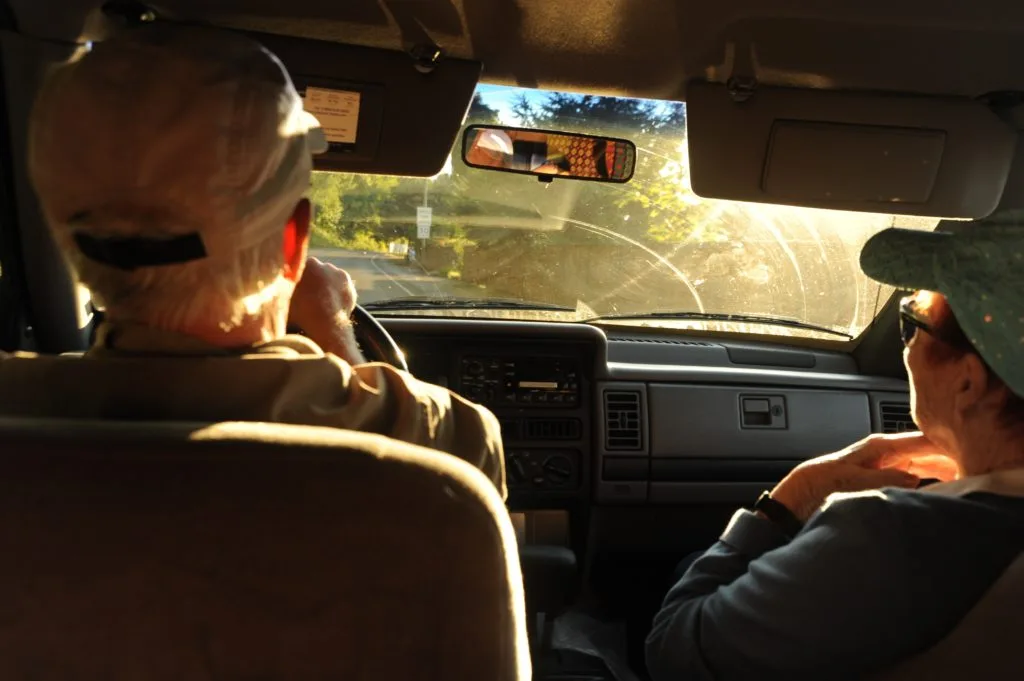Drive Safe: Guidance for Older Adults and Drivers with Low Vision
Driving is an incredibly complex, everyday task that demands sharp visual, cognitive (thinking, judgment, reasoning, remembering), and physical skills. Older adults must constantly attend to a rapidly changing environment outside the car, reacting quickly to unexpected events—like a pedestrian suddenly crossing, another vehicle’s unexpected stop or turn, or an animal darting into the street. Maintaining safe driving abilities is essential, and for some, managing the demands of the road may involve adapting to low vision.
The Critical Role of Vision in Driving
A driver’s visual system processes an enormous amount of information necessary for safe vehicle operation. Two key visual functions often decline with age and eye disease: contrast sensitivity and glare sensitivity.
Diminished Contrast Sensitivity and Road Safety
Contrast sensitivity refers to your ability to detect differences between light and dark areas. As we age, and particularly for adults with eye conditions like macular degeneration or diabetic retinopathy, this ability becomes limited. Increasing the contrast between an object and its background generally makes the object more visible. The highest contrast is typically black-on-white or white-on-black.
Seeing curbs and faded road surface markings are classic examples of low-contrast driving activities. Furthermore, rain, snow, and fog significantly reduce contrast, making the driving environment more challenging. Safe driving depends on quickly identifying subtle environmental cues. Decreased contrast sensitivity directly impacts reaction time and hazard perception.
Managing Glare Sensitivity
Glare sensitivity poses another significant challenge for many older adult drivers during both day and night.
To combat daytime glare from the sun or nighttime glare from oncoming headlights, drivers should:
- Keep all glass clean: Regularly clean your windshield, other car windows, and eyeglasses. Smudges, streaks, and dirt refract light at odd angles, intensifying glare.
- Adjust focus at night: When the light from oncoming cars shines directly in your eyes, look slightly down and to the right of the road. You can use your peripheral vision, which is generally less glare-sensitive, to maintain awareness of the road ahead.
- Use appropriate sunglasses: Sunglasses can reduce glare. Lenses with a yellow or amber tint are particularly helpful because they tend to increase contrast without excessively darkening the environment. A yellow-tinted lens can be beneficial on cloudy, rainy, or snowy days, as well as for night driving. It is the only tint recommended for use after dark.
Low Vision and the Path to Bioptic Driving
The term low vision describes significant visual impairment that can’t be corrected fully with glasses, contact lenses, medication, or surgery. However, in many states, individuals with certain types of low vision are still eligible to drive safely by using specialized adaptive aids and undergoing specific training.
Understanding Driving with Low Vision
Low vision affects a driver’s ability to clearly see road signs, traffic signals, and potential hazards. While it poses considerable challenges, it doesn’t automatically mean the end of driving. Many organizations, including Bioptic Driving USA, advocate for rigorous screening, training, and licensing programs that allow people with low vision to continue driving using adaptive equipment. The premise is that safe driving is a learned skill, and with the right tools and training, individuals can compensate for their visual limitations.
Bioptic Driving: A Compensatory Technique
One of the most recognized and successful adaptations for low vision driving is the use of a bioptic telescope system.
Bioptic driving involves mounting a small telescope, or miniature binocular, either above or within the lens of a person’s regular eyeglasses . This device allows the driver to briefly magnify distant objects like road signs, traffic lights, and street names.
Here’s how the bioptic system works:
- The driver primarily views the environment through the carrier lens (their regular corrective lens), which provides the widest field of view.
- When the driver needs to resolve fine detail at a distance, they make a quick, slight head and eye movement to view the object through the telescope.
- The use of the telescope is intermittent and brief, primarily for spotting and confirming information, not for continuous driving. The driver is taught to return immediately to the carrier lens view for general vehicle control.
Individuals pursuing bioptic driving must typically undergo extensive behind-the-wheel training with a Certified Driving Rehabilitation Specialist (CDRS). This training focuses on:
- Efficient scanning techniques to integrate the use of the telescope.
- Maintaining lane position and managing speed while using the telescope.
- Hazard perception and response.
This adaptive approach empowers individuals with low vision to retain their independence while maintaining a high standard of road safety.
Safe Driving Practices and Scanning Techniques
Regardless of visual acuity, all drivers—especially older adults—should proactively implement safe driving practices and refine their visual skills.
The Importance of Organized Scanning
Individuals with minimal vision problems who continue to drive should learn and practice organized scanning to maintain situational awareness. You can practice this technique even as a passenger:
- Begin at the left side of the road.
- Quickly scan horizontally across the road, checking for oncoming traffic, traffic lights, and pedestrians on sidewalks or corners.
- Pay close attention to “Walk/Don’t Walk” signals. If the signal is blinking “Don’t Walk,” be prepared to stop, as the traffic light is likely to change soon.
This systematic, horizontal scanning ensures you don’t miss crucial information necessary for safe maneuvering.
Suggestions for Road and Driving Safety

To maximize safety on the road, older adults should thoughtfully adjust their habits and routines:
- Know your limits: Identify and avoid environments or situations that cause distress, such as driving in heavy rain, snow, or busy, multi-lane roads.
- Drive defensively and deliberately: Stay in the right-hand lane as much as possible. Use familiar routes and stay close to home initially.
- Minimize difficult conditions: Drive primarily in the daytime if bothered by night glare. Avoid dusk hours, which are notoriously low-contrast.
- Sidestep peak traffic: Avoid rush hour or school dismissal. Mid-morning or mid-afternoon often offer clearer roads.
- Eliminate distractions: Turn off the radio. Do not use your cell phone. Refrain from eating, drinking, or smoking in the car. Limit the number of passengers to maintain focus.
- Plan routes meticulously: Plan your routes in advance, accounting for traffic patterns and complex turns. Have an alternative route ready in case of construction or accidents.
- Maintain appropriate speed: Drive within the legal limits and no slower than five miles per hour below the posted speed; driving too slowly can also be hazardous.
- Stay physically fit: Participate in a regular exercise program to maintain or increase neck and trunk mobility, coordination, and overall endurance, all of which are vital for safe steering and scanning.
Understanding Driving Restrictions and License Renewal

State licensing agencies, often guided by organizations like the American Academy of Ophthalmology (AAO) and other agencies, establish driving requirements to ensure public safety. These regulations often involve vision standards, physical health assessments, and age-related restrictions.
Visual and Medical Driving Restrictions
Standard licensing procedures typically require drivers to meet minimum visual acuity and visual field standards. When a driver’s vision or health declines, a state’s Department of Motor Vehicles (DMV) may impose driving restrictions. These are often based on recommendations from a driver’s physician or optometrist. Common restrictions include:
- Daytime-only driving: A ban on driving after dark if glare or low-light conditions severely impair vision.
- Limited geographical area: Restrictions to familiar local roads or a certain radius from home.
- Speed limitations: Requiring a driver to operate a vehicle below a certain speed limit (e.g., no driving on highways).
- Required use of adaptive equipment: Mandating the use of a bioptic telescope system or special mirrors.
Failure to meet the state’s vision standards during a license renewal can lead to a requirement for a medical or vision specialist’s evaluation or, in severe cases, to license suspension or revocation.
License Renewal and Alternatives to Driving
Many states require older adults to renew their licenses more frequently and may mandate in-person renewal and a vision test with each cycle. These measures are designed to identify drivers who may no longer meet the minimum safety standards.
If driving is no longer safe or possible, exploring local alternatives to driving is essential for maintaining independence and quality of life. Resources often available include:
- Senior and community centers: Many offer door-to-door transportation services.
- Taxi and ride-sharing services: Some offer discounts to older adults.
- Churches or neighborhood groups: These organizations may arrange volunteer drivers.
These alternatives become crucial for appointments scheduled during rush hour, in poor weather, or whenever a driver may feel unsafe behind the wheel.
Resources for Safe Driving and Assessment
Taking proactive steps to assess and maintain driving fitness is a responsibility all drivers should embrace.
- Professional Assessment: Occupational therapists and Certified Driving Rehabilitation Specialists (CDRS) can conduct comprehensive driving skills assessments and provide specialized training to improve driving, including instruction on low-vision adaptations such as bioptic driving.
- Educational Materials: The US Department of Transportation’s National Highway Traffic Safety Administration (NHTSA) Older Drivers Education website provides valuable information on programs and vehicle adaptations. The American Association of Motor Vehicle Administrators offers the Driver Fitness Medical Guidelines, which include detailed discussions on vision standards.
- Refresher Courses: Driving refresher courses, often offered by local senior centers, hospitals, or the American Automobile Association (AAA), can help sharpen skills and familiarize drivers with new laws and safety techniques.
Staying informed, utilizing adaptive technologies where appropriate, and adjusting habits as necessary are the cornerstones of driving safety for older adults and those with low vision.
Taking Control of Your Driving Future
The journey of safe driving as an older adult is not about relinquishing independence; it’s about intelligent adaptation and proactive management. Driving is a complex, demanding skill, and acknowledging the natural changes in contrast sensitivity, glare sensitivity, and cognitive function is the first step toward becoming an even safer driver.
To embrace a lifetime of safe and independent mobility, take these immediate, actionable steps:
1. Get Assessed: Don’t wait for a problem. Consult an Occupational Therapist or CDRS for a professional driving assessment to identify specific areas for improvement.
2. Use Resources: Leverage the expertise offered by organizations like AAA and the AAMVA. Enroll in a driving refresher course to sharpen your defensive driving skills and refresh your knowledge of current traffic laws.
3. Plan Alternatives: Proactively identify local transportation alternatives—from senior center shuttles to volunteer driver programs. Having a plan B ensures your independence remains intact, even if you decide to limit driving in challenging conditions, such as heavy traffic or inclement weather.
By staying informed, utilizing low vision aids like the bioptic system, and making thoughtful adjustments to your driving habits, you take control of your driving safety. Your commitment to adaptation ensures you can continue to enjoy the freedom of the road for years to come.
Learn More
- Safe Driving for Older Adults National Institute on Aging